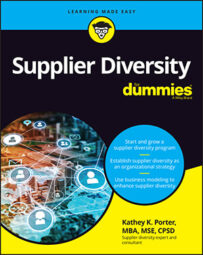Understanding supplier diversity management
Supplier diversity management (SDM) involves many interconnected functions that are difficult to manage separately and expect worthwhile outcomes. As organizations shift to build programs that are impactful and focus on adding value, they have to ensure these functions are aligned and working together:
- Your internal process: Everything starts here. This part focuses on all of your internal activities (your in-reach efforts; your programs; and your people, policies, processes, and procedures) and determines the robustness of your program. This is the heart of your supplier diversity efforts.
- Your external process: This part may be twofold. The first part is external stakeholders who can provide the motivation and push that organizations sometimes need in order to take action. The second is community outreach: actively engaging in the community to scout and recruit businesses to do business with your organization.
- Your supplier development process: As the name indicates, the focus is on development — proactively creating a pipeline of small and diverse businesses ready to do business with your organization. As organizations become more intentional about supplier diversity and allocate more time and professional resources to their programs, they have to look beyond just spend analytics.
Gauging your organization's supplier diversity readiness
Assessing readiness involves understanding organizational change management, or OCM, and the components of change (people and process).
To determine whether your organization is ready for change, ask yourself the following questions:
- How has the organization historically handled change?
- What do you need to change in order for change to occur and stick?
- How well does your organization function during change efforts?
- How disruptive will the implementation process be to the organization? Are you committed for the long haul?
- What resources do you need? Is your team ready at all levels to implement?
- Does senior leadership back and support change?
- What are your motivations for the change? What is your resistance to it?
To start the OCM process for supplier diversity, here are four mainstays that are necessary to allow the process of change to occur:
- Communication: Communication is fundamental for change. People need and want to know what is happening, when it’s happening, why/how they’re doing it, and how it impacts them. Communication provides the awareness and understanding needed for them to commit, engage, and execute the necessary change successfully.
When the organization sets expectations, uses communication tools, and proactively reduces misinformation, stakeholders are more likely to buy into making change. They will also stay more engaged and committed, which is how long-term organizational transformation occurs. Good communication should be intentional, consistent, and a two-way street.
- Sponsorship: When change occurs, people turn to leaders for direction and support. Change needs active sponsorship and engagement at the executive level to ensure a successful outcome; a project’s success is directly linked to having an active sponsor who champions the change, mitigates resistance, and builds organizational alliances. A sponsor helps build commitment and authenticity across the organization. Sponsors have ultimate responsibility for projects.
- Stakeholder management: Stakeholder management involves identifying all stakeholders and getting buy-in (that is, making stakeholders aware of the change and its benefits throughout the process). Actively engaging stakeholders early during the change process directly correlates to the success of the change.
- Preparation: The primary goal of preparation is to understand need gaps in stakeholders’ skills and provide them opportunities to expand their knowledge and understanding before the change happens. Preparation in whatever form should nurture understanding, acceptance, and commitment and build confidence for all involved in the change.
Understanding your four Ps: People, policies, processes, and procedures
The components that make up a supplier diversity system are its people, policies, processes, and procedures, the four Ps. You have to assess and manage each of these to determine your organization’s readiness and ensure the supplier diversity system functions as desired:
- People: People are arguably the most important part of your system. That starts with the person who leads the effort and their ability to be a champion and advocate for small business while being an effective influencer within the organization.
- Policies: Your policies are what guide your activities. They are a deliberate system of guidelines to direct decisions and achieve desired outcomes. In short, they give your program its teeth.
- Processes: By definition, a process provides a high-level perspective of the various tasks required to complete the work. Simply put, your processes are the required tasks that, when combined, turn your inputs (activities) into desired outputs (increased utilization of diverse vendors) and answer the question “How can my business do business with your organization?”
- Procedures: Your procedures concentrate more on the fulfillment of particular activities identified inside the business process. Many confuse processes and procedures or use them interchangeably.

